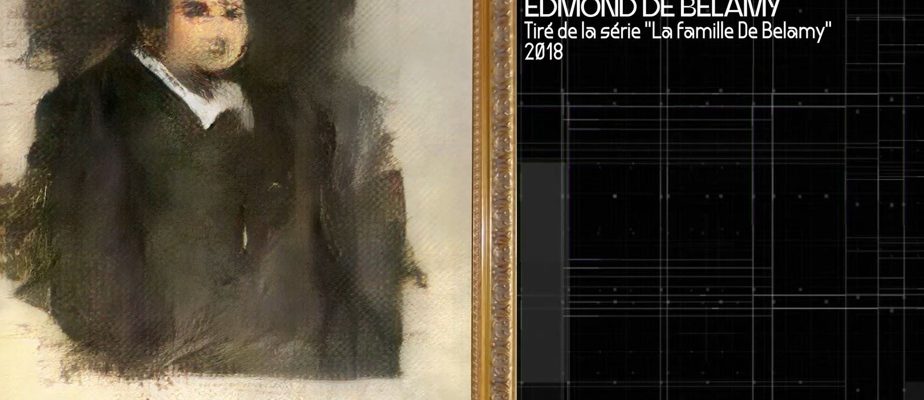“Our brush is AI! », proclaim the members of the French collective Obvious, which has been producing works generated by artificial intelligence for five years. An approach that intrigues as much as it raises eyebrows, captured in an astonishing documentary directed by Frenchman Thibaut Sève in the film Obvious, art hackerspresented at the opening of the Festival of Films on Art (FIFA) this Thursday.
The birth of this trio is improbable. Hugo Casselles-Dupré, Pierre Fautrel and Gauthier Vernier, childhood friends, embarked on the adventure in 2018, creating the fictional portrait of the Count of Belamy. A work generated by AI, powered by 15,000 painted portraits dating from the 14th centurye in the 20the century, with a surrealist touch.
This was before the popularization of DALL-E, Stability or other Midjourney image generators, which are now essential. Also before the birth of the chatbot ChatGPT. A marker in the history of AI.
But unlike many forgers who have attempted to infiltrate the contemporary art world with works generated by algorithms, the Obvious trio has never hidden their approach. From the start, he presented himself with his visor raised, arguing that what he did was also art.

PHOTO PROVIDED BY FIFA
The three members of the Obvious collective: Hugo Casselles-Dupré, Gauthier Vernier and Pierre Fautrel at the Opéra Garnier, in Paris
Auctioned by Christie’s in New York, the AI-generated portrait of Count de Belamy was bought by a Hong Kong collector for the tidy sum of US$432,500! A seismic shock in the world of contemporary art.
Artists or not?
However, are Hugo, Pierre and Gauthier artists? The question is addressed in the documentary by Thibaut Sève. Who is the artist? The one who came up with the idea for the concept? The one who designed the algorithm? Both ? Neither of the two ? Art without an artist, strictly speaking, is it really art?
In interview with The Presswe address the issue directly with Pierre Fautrel.
When we created this series, in 2018, we became artists at the same time. It’s a big status to assume, we say it in the documentary, but since we have things to say, we embrace it. We never questioned our legitimacy. Questioning society in an artistic way about the relationships we have with algorithms makes sense, even if not everyone agrees.
Pierre Fautrel, co-founder of Obvious
Luckily for them, Obvious didn’t stop there. Their second series, Electric Dreams, is inspired by the arrival of electricity in Japan, a way of addressing the fears raised by AI today. From their research on Japanese prints, they created an algorithm that generated completely original landscapes.
“This first experience pushed us to improve on all points,” explains Pierre Fautrel, “because just generating images had no artistic interest. »
One of the turning points for the trio? His meeting with the Parisian gallery owner Magda Danysz, who opened the door to her gallery and commissioned his exhibition on Seven wonders of the world. An exhibition based on serious historical content (which is also exhibited), which fed the AI and produced images with varied styles.
As the collective evolves, we realize that our three friends are not coping well with the insecurity of their lives as artists… Did they think they would become instant millionaires by working in the arts and the crypto art market?
“I don’t believe that an artist must suffer to express himself,” Pierre Fautrel tells us. I don’t believe in divine inspiration. You don’t need insecurity to be creative. On the other hand, you are right, the artist’s characteristic is not to have security at all times. But yes, it weighs. Because we are three self-taught artists and we want it to continue. »
Carry your message
The approach of Obvious, who also works with brands on design and marketing projects, and who produced a video work for the Garnier Opera in Paris, is also distinguished by his avowed desire to “please the public” who it is addressed to.
Doesn’t this popular approach go against the very reason for being of the artist, who expresses himself or creates from what he feels rather than responding to the expectations of the public? ?
We are aware that there are series that appeal more than others. Our concepts start from a desire that we have at the base. But I don’t necessarily agree with the axiom that you first do something for yourself and then see if it finds an audience. The question is whether we can convey our message around AI. If you type, the answer is no.
Pierre Fautrel, co-founder of Obvious
By working in threes – and with AI – the results generate completely different styles. Does the collective suffer from this lack of signature? Or the multiplication of styles?
“We want you to leave our exhibitions thinking about the questions we raised, but of course, the visual styles are different. Do we suffer from it? Not really. Commercially it might not be ideal, but at the same time it would feel like you’re doing the same thing every time otherwise. »
Since last June, Obvious has created a research laboratory with the Sorbonne. Research in artificial intelligence focused on the transition from text to image or video, but also from thought to image (mind to image), therefore the illustration of the brain’s thoughts, thanks to MRIs, transmitted by images.
Hugo Casselles-Dupré sums up the collective’s ambitions well at the end of the documentary: “We will never stop Obvious, it’s not something that can stop because we have nothing left in the account. Obvious is an idea, a trio of people. Unless we die, Obvious will continue. »
At the Outremont Theater on March 14, opening of the International Festival of Films on Art (FIFA); at the Phi Center on March 15 (with discussion in the presence of Obvious members); at the National Museum of Fine Arts of Quebec on March 16
Visit the FIFA page
